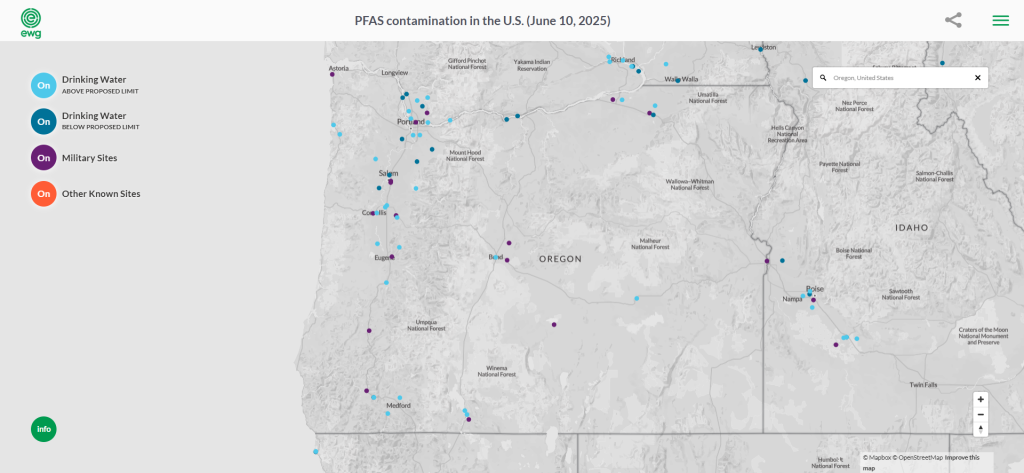- Home
- Personal Injury
- PFAS Lawsuit
- PFAS Contamination Map
- PFAS in Oregon
PFAS in Oregon
- Last updated: July 16, 2025
-
Contributor: nicky

PFAS contamination in Oregon’s water supplies is a concern as new data highlights the potential health and environmental hazards from these persistent chemicals. I have consulted reports from the U.S. Geological Survey and the Oregon Department of Environmental Quality (DEQ), which indicate that PFAS—sometimes called “forever chemicals”—resist breakdown and can remain in groundwater, soil, and even the human body for extended periods. According to a federal study, an estimated 800,000 Oregonians could be relying on wells that contain PFAS at varying concentrations (U.S. Geological Survey).
PFAS stands for per- and polyfluoroalkyl substances, a vast class of more than 4,000 synthetic chemicals. Historically, manufacturers used them in diverse consumer and industrial products such as firefighting foams, non-stick cookware, and water-resistant clothing. In the following sections, I will outline what makes PFAS so dangerous, where they have been detected in Oregon, the known health impacts, and what steps local authorities and public health experts are taking. I will also discuss how to test for PFAS, possible legal remedies for affected communities, and ways a specialized service can help connect individuals with legal representatives.
What are PFAS and why are they dangerous?
PFAS are man-made compounds praised for their grease-, water-, and stain-repellent properties. They appear in products like fast-food packaging, carpets, cosmetics, electronics, and some industrial processes. Initially introduced in the 1940s, PFAS soon became a staple in countless applications because of their ability to repel moisture and resist degradation.
Yet these same properties explain why PFAS pose significant environmental and health dangers. They do not readily degrade in soil or water, and they can accumulate in living organisms over time. Researchers link PFAS to elevated risks of cancers, high blood pressure, and metabolic disorders, although exact effects depend on exposure levels and specific PFAS compounds.
Manufacturers produced and used many PFAS variants without fully evaluating their toxicity. In response, public health agencies began compiling evidence on how these chemicals move through ecosystems. The U.S. Environmental Protection Agency (EPA) has issued health advisories for several PFAS compounds, urging public water systems and consumers to be vigilant. One concern is how small amounts, ingested daily over many years, can accumulate in the human body.
Through advanced testing procedures, scientists differentiate between numerous PFAS subtypes such as PFOA, PFOS, PFHxS, PFNA, HFPO-DA (GenX chemicals), and PFBS—each with recognized toxicity profiles. Recent regulations in 2024 set Maximum Contaminant Levels (MCLs) for six PFAS compounds, paving the way for stricter oversight in Oregon and nationwide.
Where are PFAS found in Oregon?
Oregon has identified PFAS in multiple environmental settings. Wastewater plants are not the original source of PFAS, but they receive discharges from industries and households that use or dispose of products containing PFAS. This inflow can carry PFAS into local waterways or municipal sludge, amplifying the risk to both drinking water and agricultural soils.
Additionally, a 2018 statewide drinking water survey discovered elevated PFAS levels in select regions. Although not every public water system reported contamination, concerns persist for private wells, which often lack routine testing. Some residents, especially those in rural areas, are unaware that everyday household items—including water-resistant clothing or grease-proof packaging—could be contributing factors.
The DEQ places PFAS within the Toxics Reduction Strategy’s priority chemicals list, committing the agency to more monitoring, control efforts, and cleanups. DEQ data shows PFAS detections in soil and surface waters, sometimes surpassing health-based screening levels. This has prompted cooperation among Oregon Health Authority (OHA), local governments, and community groups to address the continued presence of these chemicals statewide.
PFAS in Oregon’s drinking water
I have seen heightened public interest in PFAS in Oregon’s drinking water due to the many residents reliant on wells or municipal supplies that may be at risk. Oregon is currently ranked 25th nationwide for possible PFAS contamination in private and public wells (U.S. Geological Survey). While not all regions test positive for contamination, localized hotspots raise important questions about long-term safety.
Cities and counties with detected PFAS levels
Information about which cities or counties have reported PFAS varies, but limited testing reveals higher concentrations near industrial complexes, firefighting training sites, and areas where certain firefighting foam—called aqueous film-forming foam (AFFF)—has been deployed. Researchers also identified potential conveyor points along river systems that serve as sources for municipal water.
Some data suggests communities near manufacturing or processing plants may record higher numbers of PFAS detections. According to DEQ updates, more testing in Medford, Salem, Portland, and surrounding areas could provide an accurate picture of the extent of contamination, but efforts remain partial. Complying with 2024 EPA rules means that utilities will need to keep PFAS levels below the new enforceable limits or face penalties.
Oregon Health Authority (OHA) testing programs
The OHA oversees testing programs under the Third Unregulated Contaminant Monitoring Rule (UCMR3), requiring public water systems to periodically report on emerging compounds like PFAS. Under this rule, OHA collects data on possible contamination and works with the EPA to decide whether formal regulations are necessary.
Some water systems participated in earlier sampling efforts, passing on findings that help authorities identify health risks. Once contamination is confirmed, water managers can either treat the supply, find alternative sources, or advise residents about potential exposure. OHA is prepared to adopt and enforce the federal MCLs for PFAS, ensuring consistent protection across the state.
Potential sources: AFFF firefighting foam and industrial discharges
One of the well-documented uses of PFAS is in firefighting foam, especially AFFF that produces a fast-spreading film to extinguish fuel fires. Experts point out that foam usage can lead to groundwater contamination near military bases, airports, and firefighting training centers. Oregon has historical industrial operations—such as chrome-plating or electronics manufacturing—that also used PFAS in their processes.
Industrial discharges may enter sewers or septic systems, ultimately reaching treatment plants unequipped to remove all PFAS. In response, local authorities have begun tracing PFAS at its origin, encouraging product substitution or stricter onsite waste disposal. While these measures may take years to implement fully, they reflect a growing collaborative approach to keep PFAS out of Oregon’s water supply.
PFAS in Oregon’s soil and agriculture
PFAS are often detected in soil where industrial runoff, biosolids, or firefighting foam residue accumulates. Farms that use sludge or compost derived from municipal wastes can unknowingly introduce these chemicals to agricultural lands. The concern lies in PFAS potentially moving from soil into crops, and eventually onto tables in the form of produce or livestock feed.
According to the DEQ, there is limited yet concerning evidence that PFAS can accumulate in certain crops. I have read statements noting how PFAS infiltration into plants is dependent on factors like soil composition, water usage, and the particular PFAS compounds present. Oregon’s agricultural industries rely heavily on clean water resources, so the prospect of PFAS-laden soils underscores the importance of ongoing testing and research into safer soil amendments.
Health effects of PFAS exposure
Scientists have linked PFAS to a range of adverse health effects. The Centers for Disease Control and Prevention (CDC) cites studies showing associations with:
Kidney cancer and testicular cancer
Elevated cholesterol levels
Liver or thyroid disruption
Immune system deficiencies
Reproductive issues
While the severity of these outcomes depends on the levels and duration of PFAS exposure, the persistent nature of PFAS makes them especially concerning. Even low levels, accumulated over many years, can impact bodily systems. Ongoing research will likely better define exposure pathways and disease outcomes, but current consensus supports strong caution around PFAS ingestion.
PFAS-linked diseases in Oregon
In Oregon and across the country, researchers attempt to piece together how PFAS contamination translates into real-life diagnoses. I have often encountered discussions about whether certain cancers or metabolic problems occur at higher rates among communities with known exposure. Though proving a direct cause remains complex, enough data exists to justify alerts and health advisories.
Kidney cancer
Long-term ingestion of specific PFAS compounds has been correlated with higher risks of kidney cancer. Elevated PFAS blood levels can disrupt kidney function and cause cellular damage over time, according to toxicological data from the EPA. As the kidney plays a vital role in filtering blood, any chemical with a high persistence rate in the body raises concern.
Testicular cancer
Studies from regions with documented PFAS releases have examined testicular cancer rates. According to several epidemiological reviews, the association is suggestive yet not definitively proven for every PFAS subtype. Nonetheless, public health officials note the importance of early interventions—like providing clean water supplies—to minimize the potential burden on community health.
Thyroid disease
Some PFAS compounds appear to affect the thyroid gland. Thyroid hormones regulate metabolism, and any interference can lead to weight changes, fatigue, or more serious complications. In Oregon, individuals experiencing unexplained thyroid-related issues sometimes question whether PFAS exposure is a contributing factor, particularly if they live near known contamination sites.
Liver damage and cholesterol changes
High-level PFAS exposure may generate abnormal liver-enzyme tests and contribute to long-term liver toxicity, as indicated by animal and human studies (EPA). Additionally, researchers found potential links between PFAS and elevated cholesterol. Individuals concerned about these outcomes are often advised to consult medical professionals for appropriate blood tests, especially if they live in areas of known PFAS contamination.
How Oregon is responding to the PFAS crisis
Local agencies, in collaboration with federal bodies, are rolling out measures to identify and reduce PFAS contamination. New regulations introduced by the EPA in 2024 require states to meet legally enforceable drinking water standards for six PFAS compounds. Oregon’s plan involves cross-agency cooperation to ensure compliance, outreach, and pollution prevention.
Oregon Department of Environmental Quality (DEQ) initiatives
DEQ has categorized PFAS as one of its 60 priority chemicals within the Toxics Reduction Strategy. One approach includes setting “initiation levels” for PFAS in municipal wastewater effluent. If facilities exceed those benchmarks, they must develop pollution prevention plans. DEQ also urges consumer awareness about PFAS-laden products—ranging from waterproof clothing to grease-resistant food wrappers—because sourcing alternatives can lessen environmental loads.
DEQ’s involvement spans permitting, monitoring, and cleanup activities. It works with the Oregon Health Authority to evaluate potential hotspots and advises local governments on best practices. Some groups also collaborate with universities, pushing forward research on PFAS detection, toxicity, and remediation.
Groundwater monitoring and testing grants
Recognizing that smaller water systems and underserved areas often lack resources, Oregon has introduced grants for groundwater monitoring projects. These funds can be used for:
Purchasing PFAS field test kits
Conducting lab-based sampling
Training local officials in water-quality data interpretation
Supporting well owners who voluntarily test for PFAS
By expanding the number of tested sites, authorities hope to create a more detailed map of groundwater vulnerabilities. This data could guide future regulations and pinpoint urgent cleanup needs.
Collaboration with federal agencies and EPA guidelines
Oregon coordinates with the EPA, which has classified PFOA and PFOS—two of the most common PFAS compounds—as federal hazardous substances. This designation compels responsible parties to fund investigations or cleanups if contamination triggers health and environmental risks. Federal guidelines also facilitate interstate communication, allowing Oregon to learn from states like Washington or Minnesota that have taken similar steps.
Maintaining alignment with EPA rules ensures Oregon can respond efficiently to emerging science. The 2024 MCLs for PFAS require public water systems to position themselves for increased transparency, routine testing, and possible infrastructure upgrades. By following these guidelines, Oregon aims to prevent further contamination and safeguard public health.
Can you test your water or soil for PFAS in Oregon?
If you use a private well, you can test for PFAS by contacting accredited laboratories capable of analyzing water samples. Some local health departments offer guidance or may have partnerships that reduce costs for low-income residents. While this testing can be more expensive than standard water tests, it provides a baseline to determine what levels of PFAS—if any—might exist on your property.
Soil sampling is also available to detect PFAS accumulation. Agricultural producers, landscapers, or homeowners concerned about contaminated biosolids can work with environmental consultants for specialized testing. Keep in mind that testing procedures for PFAS require technical expertise, and not every lab is equipped to process these samples reliably.
Do you qualify for a PFAS lawsuit in Oregon?
If PFAS exposure has affected your health, property, or livelihood, you may be eligible to file a lawsuit seeking damages. Common grounds for legal action include personal injury, property devaluation due to groundwater contamination, or medical expenses connected to PFAS-related diseases. An attorney typically reviews factors such as:
Documented presence of PFAS above health-advisory levels
Demonstrated links to specific polluters or manufacturers
Medical diagnosis potentially connected to PFAS exposure
Economic or non-economic harm inflicted on you or your family
I encourage you to learn more about PFAS lawsuits and how to determine eligibility. For additional information, you may visit the official PFAS Lawsuit page here: PFAS Lawsuit. If water sources on your property were compromised, you can also consult: Water Contamination Lawsuit for more details.
Why choose Legal Claim Assistant
I understand that legal action can be daunting, especially for a complex issue like PFAS contamination. Legal Claim Assistant offers a streamlined approach to connecting you with the right attorney who understands environmental law and toxic tort cases. By working with an experienced professional, you can gain clarity on whether your situation merits legal pursuit.
Legal Claim Assistant aims to simplify the entire process for individuals who suspect that PFAS contamination has directly harmed their health, property, or livelihood. They can match you with lawyers specializing in PFAS litigation, ensuring your claim is properly evaluated. If you believe PFAS exposure in Oregon has negatively impacted you, a free case review can be the first step toward potential compensation.
Frequently asked questions (FAQ)
Below, I have compiled answers to common questions about PFAS contamination in Oregon. These address detection, public health measures, agricultural concerns, legal rights, and more.
PFAS contaminants have been found in multiple parts of Oregon, including surface water, groundwater, soil, and even fish. According to DEQ, affected areas include sites near industrial complexes, military installations, and firefighting training areas where AFFF foam may have been used. While some regions show minimal or no detection, ongoing testing may reveal additional hotspots.
Yes. Private well owners are encouraged to use accredited labs that specialize in PFAS testing. Some counties may offer assistance or reduced-cost testing kits, so you can contact your local health department for more information. Public water systems are also obliged to comply with state and federal regulations, including routine reporting, to ensure that any PFAS contamination is discovered and addressed.
If you live outside New Jersey but worry about similar contamination, you can learn about other states’ PFAS issues, such as in Minnesota and Michigan.
DEQ has named PFAS one of its 60 priority chemicals under the Toxics Reduction Strategy. Initiatives include establishing PFAS “initiation levels” for wastewater plants, promoting product substitution, and guiding pollution-prevention planning. DEQ coordinates with the Oregon Health Authority and the EPA to implement monitoring, fund testing, and require cleanup when necessary.
PFAS can enter crop fields through contaminated soil amendments like biosolids or irrigation water. Some research indicates that certain plants may absorb PFAS more readily than others. Oregon’s agricultural sector depends on routine water-quality checks and is part of ongoing monitoring programs. Farmers who suspect PFAS contamination in their soil can request specialized testing and explore safer fertilizing options.
Researchers connect elevated PFAS levels with serious conditions such as kidney cancer, testicular cancer, thyroid disease, liver damage, and abnormal cholesterol levels. The precise effects vary by PFAS subtype and exposure level, but long-term ingestion of contaminated water or food may raise the risk of these diseases. Organizations like the EPA and CDC provide extensive scientific literature on these health outcomes.
Many individuals across the country have pursued legal actions related to PFAS contamination. If you have verifiable PFAS levels in your water or soil, medical diagnoses plausibly tied to PFAS exposure, or financial losses from devalued property, you may qualify for a lawsuit. It can be beneficial to work with a service like Legal Claim Assistant to find an attorney who specializes in PFAS cases. They can review your situation, gather evidence, and advise you on potential legal pathways like the DuPont Lawsuit.
Overview PFAS contamination in the USA
Here you van find the PFAS watercontamination map of the United States. Find, state by state, where water contamination has occurred due to PFAS exposure.
- PFAS in Alabama
- PFAS in Alaska
- PFAS in Arizona
- PFAS in Arkansas
- PFAS in California
- PFAS in Colorado
- PFAS in Connecticut
- PFAS in Delaware
- PFAS in Florida
- PFAS in Georgia
- PFAS in Hawaii
- PFAS in Idaho
- PFAS in Illinois
- PFAS in Indiana
- PFAS in Iowa
- PFAS in Kansas
- PFAS in Kentucky
- PFAS in Louisiana
- PFAS in Maine
- PFAS in Maryland
- PFAS in Massachusetts
- PFAS in Michigan
- PFAS in Minnesota
- PFAS in Mississippi
- PFAS in Missouri
- PFAS in Montana
- PFAS in Nebraska
- PFAS in Nevada
- PFAS in New Hampshire
- PFAS in New Jersey
- PFAS in New Mexico
- PFAS in New York
- PFAS in North Carolina
- PFAS in North Dakota
- PFAS in Ohio
- PFAS in Oklahoma
- PFAS in Oregon
- PFAS in Pennsylvania
- PFAS in Rhode Island
- PFAS in South Carolina
- PFAS in South Dakota
- PFAS in Tennessee
- PFAS in Texas
- PFAS in Utah
- PFAS in Vermont
- PFAS in Virginia
- PFAS in Washington
- PFAS in West Virginia
- PFAS in Wisconsin
- PFAS in Wyoming
Related Article

What Philips CPAP Machines Are Recalled and Why

